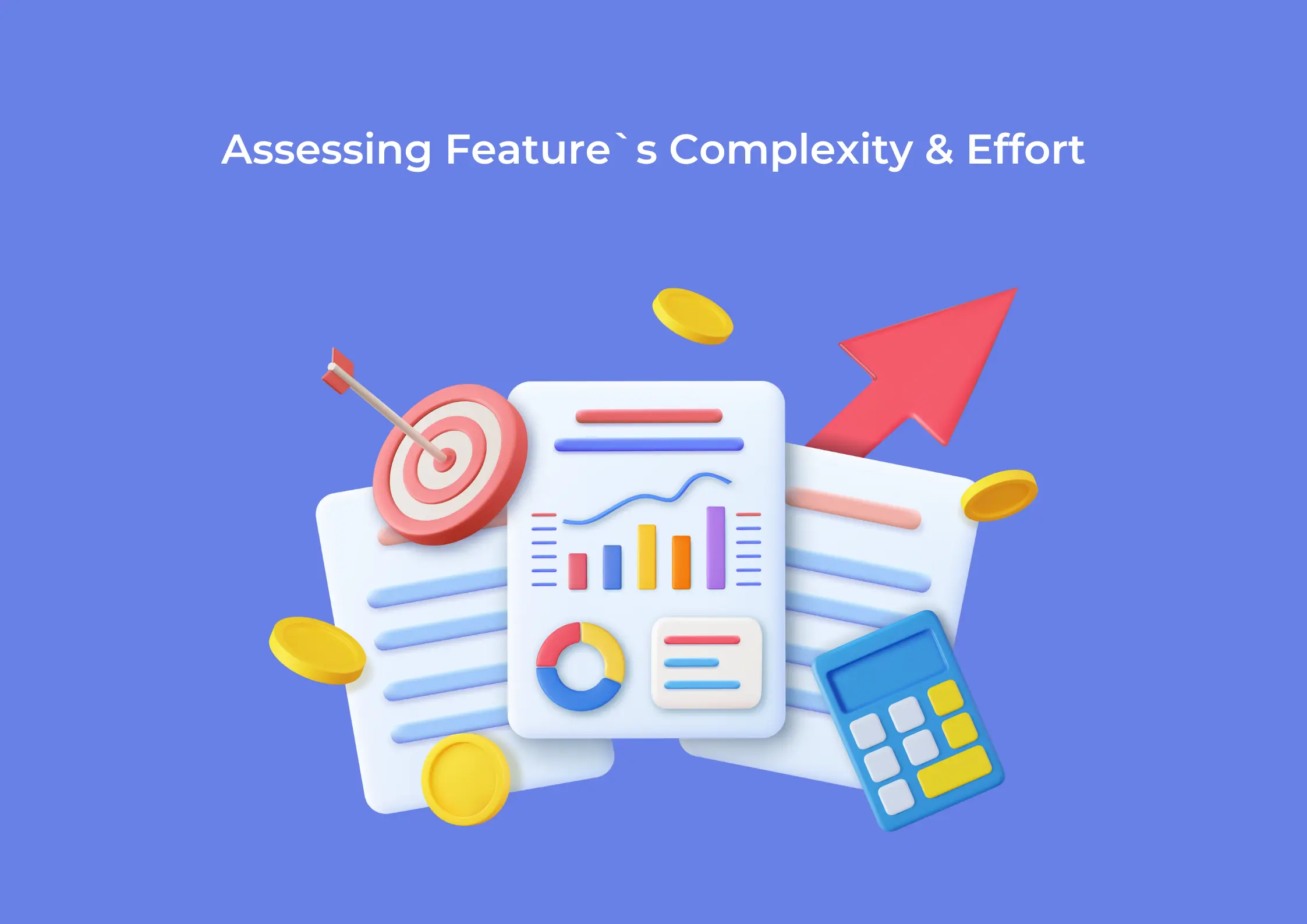📢 Sign up to my newsletter and never miss a beat!
If you are a software subscription company, you are highly likely (as well as your competitors) to already offer a free plan for freemium users, especially if your subscription model is based on tiered plans. If that`s not the case with you, maybe it`s time to consider it as part of your product growth strategy. With the market becoming denser and denser with all kinds of SaaS and app products sprouting to fill in gaps and facilitate all fields of our lives and business, competition is constantly on the rise. This drives customer acquisition costs up and forces us to come up with more alternative ways to convince potential users why our product can be of benefit to them. In fact, very often this includes providing them with some kind of value before they have paid for our product to experience the full benefits of it.
What is freemium?
The freemium model for SaaS companies can be either offering а free plan in addition to the paid version (the paid plans) of your software, or a free trial of the paid version (or the paid plans) of your product. Both have their advantages and each can be a more relevant option for different industries and types of businesses. In many cases, you can also combine both freemium models to achieve higher customer acquisition and freemium-to-paying conversion rates.
Today, we are taking a closer look at free plans specifically, the benefits of having such, and how you can tackle its users to convert to paying users.
What are the benefits of having a free plan?
1. The Customer Acquisition Cost (CAC) for users acquired through free plans is almost half the CAC for users acquired without having a free plan.
According to Profitwell, which dug into data from 646 subscription companies in 2021 for a report on the future of the freemium model, the CAC for users acquired through free plans is almost half the CAC for users acquired without having a free plan. Of course, it highly depends on the type of industry you are in, as well as other factors that can impact the CAC, but individual industry benchmarks aside, this is how things seem to be on average and for most of the SaaS companies.
As touched on in the next points, users acquired through a free plan are given more time to get properly acquainted with the product, and to experience its benefits firsthand before they commit, in comparison to the most widely offered 14-day free trials for the paid plans. Not to mention you can capture a bigger number of target users with your free plan than if you didn`t have it at all. You can also take advantage as your marketing team will have more opportunities to nurture these better-targeted leads through some free channels, such as email, in-app or direct marketing. All of these factors, drive CAC much lower and as we know, this is crucial for today`s highly competitive landscape.
2. It lets users move at their own pace without feeling pressed and convert whenever they are ready
Some prospects may need more time to convert. This can be simply because a 14-day trial is not enough for them to make a decision, as for such a short time period they cannot incorporate the product into their daily routine or workflow and properly test how it will benefit them, or they`re just not ready yet because they haven`t reached the necessary scale that justifies the investment (which doesn`t mean they won`t reach it, they just need more time). You don`t want to lose this pool of well-targeted users, do you? Allowing them to use the free version of your product indefinitely will make them familiarized with it, get used to it, and perhaps even incorporate it into their workflow. That way, when the right time comes and they`re ready to convert to a paid plan (for some people it can take a few weeks or months, while for others up to few years), your product will be the one who will naturally come into their minds as the first possibility to consider.
3. Gather more information about your users
By getting people to use a free version of your product, you can also take great advantage of free information you`ll acquire on your target users, including how they use and interact with your product, as well as what their characteristics, pain points and needs are. They`re also a valuable source of feedback and suggestions. Use that knowledge to craft your marketing strategy and to improve and enhance your product.
4. The word-of-mouth effect
If users find real value in your free plan, they will share it with their peers and happily reccommend it to others. This can potentially lead to the word-of-mouth effect, better brand recognition among your target audience and having more users with similar needs signing up Above all, it`s for free, they don`t loose anything in signing up, especially if it was recommended by someone already using it and seeing positive results. As already mentioned, Increased user base is always a good way to get free market and user knowledge and an opportunity to convert more people into paying users.
Tips to convert free plan users into paying users
The reality is that if you have a free version of your product, there will always be freemium users that will never convert into paying and are here solely for the purpose of taking advantage of your free features. In fact, it is highly possible that most of them will be such and only small number of those that have signed up will convert. Even so, don`t forget that having a free plan is, above all, a customer acquisition strategy and will benefit you in long term as well. Yes, it costs you money and resources to build it and maintain the product infrastructure, but which marketing acquisition strategy doesn`t cost you resources? if you manage to sustain a small, but consistent conversion rate (for many industries around 5-10%), it can prove to be the right tactics for you. Besides, the insights you`ll get from how these people use your product and their feedback, can be invaluable to you, as a product manager.
So ,how to increase your chances of converting them into some of your paying plans? Here are some specific tips that I shortlisted based on my experience that, I believe, will help you greatly:
1. Offer a reverse trial to new users
The concept of reverse trial is giving users access to the paid version of your product, or to some of your paid plans, for a limited time period (in other words, a free trial to your paid plan), and then downgrading them to the freemium plan when the trial expires. It is considered that, this way, you get the best of both freemium strategies. Traditionally, the free trial model has a higher conversion rate in compare to the free plan model, but this is balanced by the fact that latter usually gets bigger audience to join. At the end of the day, lower percentage of a bigger number of users is not always smaller than higher percentage of a smaller pool of users, registered on a free trial. By adopting the reverse trial strategy, you can capture the bigger number of users that will come along, as a result of being enticed by the idea of a free plan that lasts forever, and at the same time, those that represent your warmer audience and would sign up for a free trial to your paid version anyway and let that higher number of users experience your premium features first-hand.
Monday.com, a popular work management platform, is an example of a successfully adopted reverse trial strategy. Тhey offer three main products, serving different departments and their specific needs. Their different products have either three or four pricing plans, but whichever platform you choose to sign up for, you are first led to experience a 14-day trial of the respective pro plan, upon the expiration of which, you are given the choice to either continue with that plan, downgrade to a lower one, or to their free plan.

2. Identify the one factor/feature that is your Unique Selling Point (USP) and focus on promoting it
Your users should enjoy the free version of your product and, to some extent, benefit from it, but don`t forget you should give them an incentive to upgrade. That incentive can be different for your different audiences (you may have few) and should be strong enough to convince them to sign up for your paid product. Usually, there will be one big decisive factor that is the user`s main reason to upgrade. We can call it your Unique Selling Point (USP). By looking at and examining different SaaS companies pricing plans, you can spot what is their USP sometimes immediately and quite easily. For example, what do you think that main feature is for Zoho Webinars from the image below? They have 3 different plans: Free, Standard and Professional. If you want to find out, have a look at what is offered in their free plan and the one, successive to it. What is the one, big factor that differentiates the standard plan from the free plan, providing that it offers six additional functionalities? We can conclude that, for webinar organizers, the capacity to record their webinar sessions is the next most essential thing, after the access to a platform allowing them to conduct such. The rest of the perks offered in the standard plan can be referred as “supporting functions” that come in the package along with the main functionality.
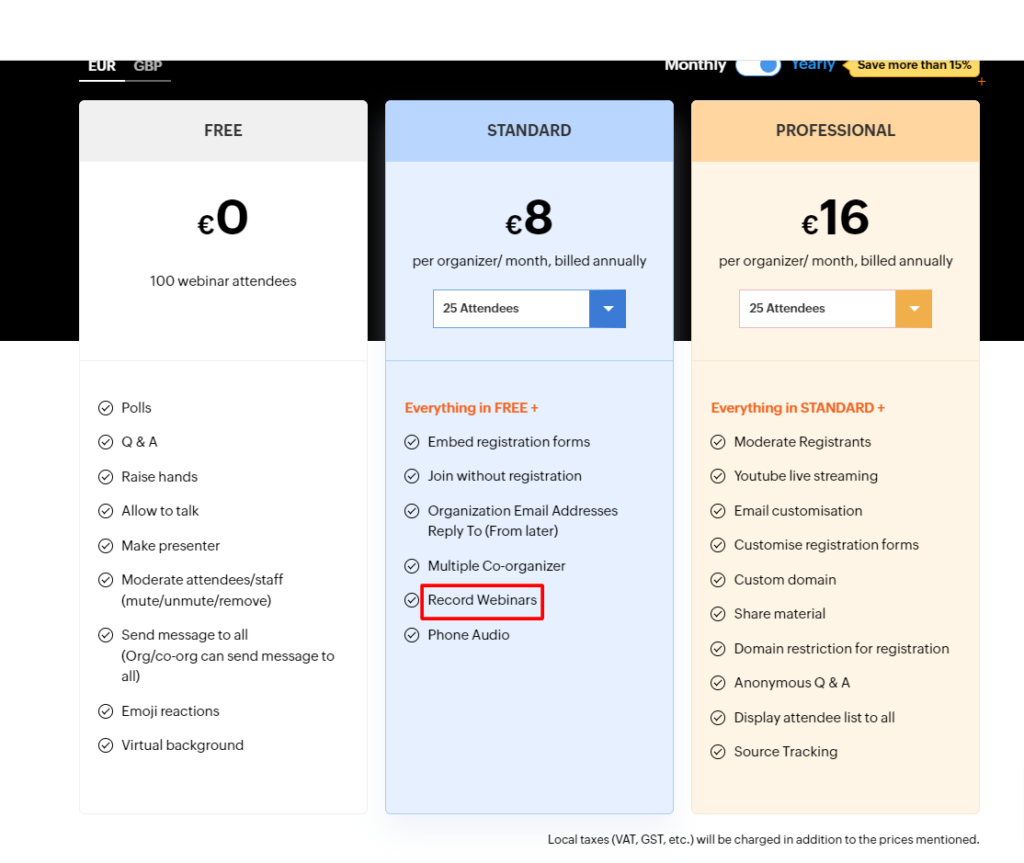
It is essential to identify your USP, so that you know where your leverage is. This is done by carefully studying your existing paying users and target audience/market and their needs. The most basic way to find it out is to survey them what has made them to upgrade, what is the one feature they love the most, what is functionality they use the most, and other things of that sort. Once you find out, focus the communication with your free users and your promotional efforts around it. If you don`t offer the reverse trial option that we discussed in the point above, you can give free users a temporary access to that feature, so that they can try it out themselves. There is no better persuasion technique than that. If you don`t want to, or you don`t have the technical capability to give them a temporary access, that`s fine as long as you incorporate it in your marketing message.
3. Make it easy to upgrade and downgrade
Today, there is an entire SaaS sub-industry that exercise various dark tricks to put on barriers for users to cancel their subscriptions. That way, they maintain an artificially lower churn rates and continue to charge money from users that have either forgotten about their subscriptions, don`t have the time to go through the whole cancelation flow or give up in the process/leave it for later. These shady tricks can be anything from hiding the cancel button, making the process too long and of multiple steps (in other words, making it appear more complicated than it actually is), to requesting a call in order to cancel the subscription in the hope that they`ll be able to put a sales pressure on the user to stay. Needless to say, these tricks are nothing but frustrating for the end user and no SaaS company that cares about their brand reputation and long-term growth and success, would use them. The customer experience around the cancelation flow is still a customer experience and can be either a positive or a negative such. Users form their perception of your brand and judge you not only based on the onboarding they received, or the experience they had while using your product, but also in situations like this. You might be asking yourself things like “Why should I care about what people that no longer wish to use our product think?”. Well, you should, because sometimes this can cost you a negative word-of-mouth or a bad review on a popular rating website that will put off a lot more people (and you should never underestimate the power of these sites as they normally generate a huge amount of well-targeted traffic, so the risk of screwing up with your audience here is pretty high). Besides, users cancel their subscriptions for different reasons. Sometimes, they cancel just because they do not need the paid version of your product at this very moment, but they would consider subscribing to it again in the future should the right necessity arise or even if they switch to another company. That is why, it is important to leave a positive impression, rather than creating a horrible deactivation experience, as well as remind these people they can unsubscribe easily at any point. In fact, you should incorporate this in your free-to-paid conversion strategy. By knowing they can cancel just by the click of a button, people are actually more inclined to subscribe in the first place. We all use a whole bunch of subscription services and it is difficult for us to keep track of all of them. In addition, many are just too busy with other, more important things than just sitting and deactivating accounts. That is why, users highly value companies that have made it easy for them and save them time. This would definatly give you a competitive edge. What you should do:
- Make the cancellation flow as plain as possible. Include a cancellation button somewhere visible. For example, the account page.
- LET YOUR FREE USERS KNOW THEY CAN EASILY UNSUBSCRIBE AND SUBSCRIBE AT ANY POINT! There is no big point in making the whole thing easy if these users you are trying to convert, are not made aware of it. It gives you a competitive edge and will increase your conversion.
Netflix is an example of easy account suspension flow. The button is made quite obvious. When you go to the Account page, you can see it straight away, just below the Membership and Billing section and above the Plan details. When a subscriber clicks on it, they are given the option of suspending their account only for a given time period. If the subscriber still wants to cancel, Netflix clearly communicates when the service will end.
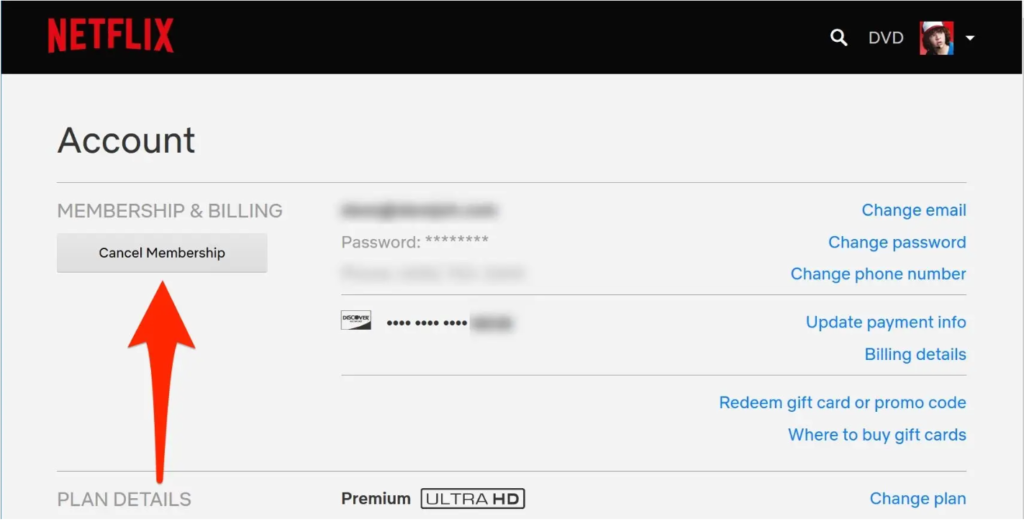
4. Highlight free usage limitations, while demonstrating the added value of the paid version
Another effective way to encourage free users to convert to your paid plan is to employ visual cues that emphasize the limitations of the free version of your product while simultaneously showcasing the added value of the paid version. By highlighting the constraints of the free plan, such as through clear icons, graphics, labels, or tooltips within the interface of the app/tool, users can quickly grasp the specific limitations they have by using the free version and realize the need for a more comprehensive solution. They will be more likely to recognize your product`s value and be motivated to upgrade to unlock these enhanced features and functionalities.
Semrush, Medium and Canva are only few of the examples of companies offering free plans that have managed to successfully incorporate this strategy on their platforms which, for sure, gets them a decent number of conversions each month.
Semrush is a valuable tool that empowers copywriters do their better in creating SEO-optimized content. They offer various features, all part of the SEO professional`s toolbox. From researching keywords/queries and exploring keyword ideas, to analyzing competitors and their backlinks, referring domains, search traffic, etc, as well as comprehensive reports. All of these functionalities however, have their volume and usage limitations for their free plan, which are lifted once you upgrade to either their Pro or Guru plans. In fact, if you need to do more in-depth and serious research from which to draw fuller and more accurate conclusions, you need to be on their paid plans (you can`t learn a lot from 10 competitors’ backlinks or 10 keyword variations). You also get some reports only if you pay. Overall, Semrush does a great job showcasing these locked features and the missed opportunities you have as a free plan user.
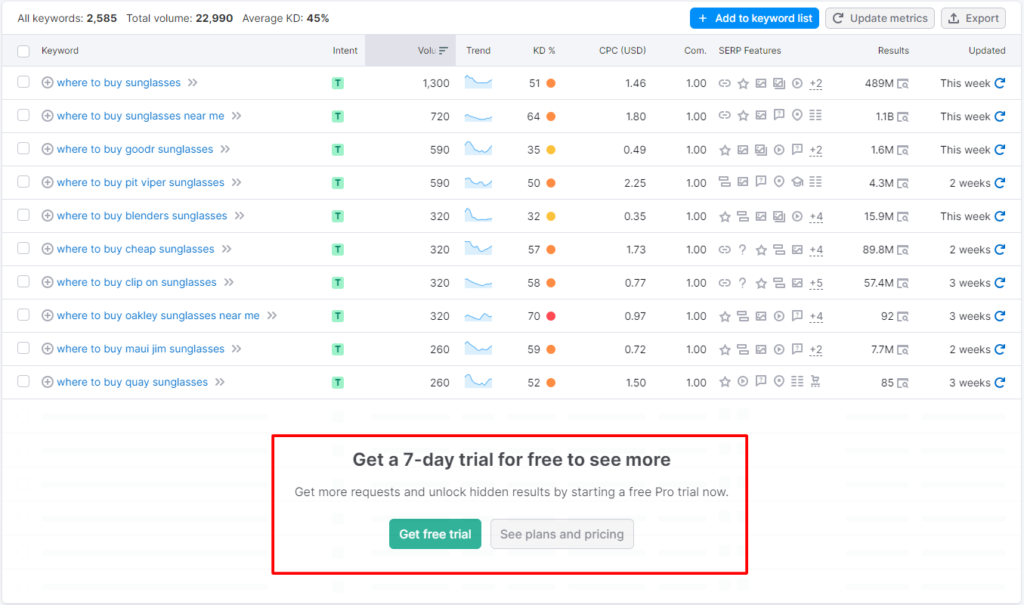
Medium, an online content publishing platform, does something very similar. It offers two types of content – free and premium. Free for the unregistered and registered free plan users, and premium for the paid users and free users that still haven`t run out of their 3 premium articles they have for free each month. Once you`ve reached that limit and you want to read more of the premium content, you are shown only the first one or two paragraphs of the article, but the rest of it is blurred by a message prompting you to upgrade your plan in order to gain access to the whole content. As you can see, this message highlights the benefits and the added value you`ll get by upgrading.
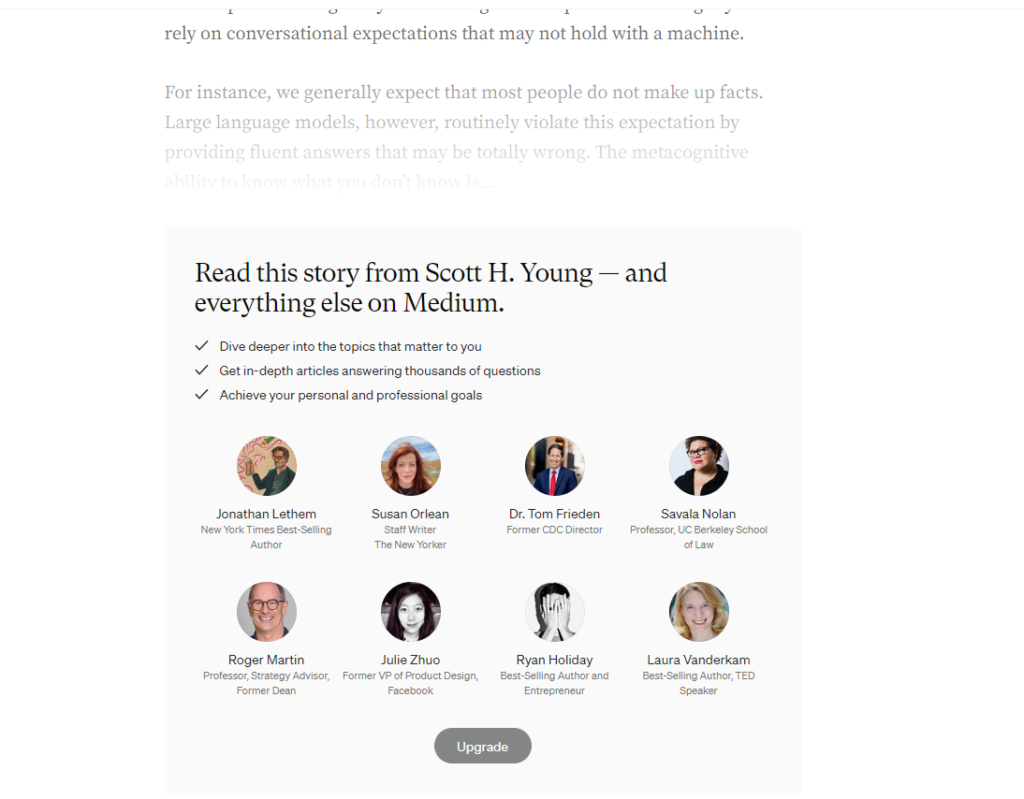
Another quite popular approach to emphasize the limitations of the free product usage versus the benefits of the paid version of the product is to display locked premium items next to the free ones. For example, in their search results, Canva displays premium visuals along with free ones. Needless to say, it won`t take long before you realize you can do a lot more and much better designs with the paid elements.

5. Use contextual and personalized in-app upgrade notifications
Contextual and personalized in-app upgrade notifications are another, highly effective, way to boost free-to-paid conversions. Instead of prompting common upgrade message randomly to all users (which can lead to annoyance), it requires setting up certain triggering rules and personalizing them based on user behavior, preferences, or usage patterns. In fact, you can have many different types of in-app notifications, each serving different purposes (user onboarding, retention, updates, and other announcements, etc) and types of audiences (new users, users on paid plans, etc). If you want to increase your free-to-paid conversions, do not miss on implementing this technique to your free plan users in the context of upgrading. The way you’ll apply it depends on the type of product, its structure and functionalities. The important thing is to ensure it is relevant and personalized to your users. Some ideas can include:
- Create a quick survey while onboarding users and use the information gathered to segment users based on their answers and to tailor the right message for each group (for example, based on their needs, interests and the preferences they indicated).
- Segment based on usage patterns and behaviour within the tool and prompt notifications accordingly.
- Trigger notifications when a specific action is undertaken by the user.
- Leverage data from users that have already upgraded to learn more about your product`s audience. That way, you can identify specific patterns, interests and needs your newly registered and free users may have and exploit this knowledge to craft your message acordingly and place it within the right context.
- Place upgrade notifications based on what the user is searching for in your app.
To sum it up:
Implementing freemium model in the form of a free plan for your SaaS business can be a winning customer acquisition strategy that will probably bring you a number of benefits, among which lower customer acquisition costs, more sign ups, valuable data for your target market and users, a great support to your marketing function, and many others. We can see an exceptional growth in a lot of popular companies that have been implementing it. To leverage its advantages however, you need to use it wisely. Do not overdo and do not include more than what is necessary to the free package, so that freemium users are kept motivated to upgrade. Remember to research the market and never cease studying your users, so that you know what would incentivize them and adjust your conversion strategy accordingly. I would say that a proper segmentation and personalization is one of the keys to success here.
On the flipside, we have to admit that this freemium model does not always work well for all businesses. If you don`t succeed with it, it’s not necessary that you did something wrong marketingwise. It may be just a result of bad judgement of the market and a poor decision being made to offer a free plan in the first place. It some cases it is preferable not to apply this method (or pick a free trial instead), as this can only harm your revenue and business model. Thus, it is very important to make your own assessment of the situation and act accordingly, Wes Bush, the founder of ProductLed, has written a very useful and in-depth article on this matter, that I believe will help you make a better-informed decision and find out what model will be most appropriate for your product. He takes into account the various types of businesses and market conditions you may operate in, to suggest you the most suitable option for you.
Want to Explore More on This Topic?
Delve deeper with these curated resources! Discover insightful articles, expert blogs, and top-rated books to enhance your knowledge and skills.
Note: Some links are affiliate links, which means I may earn a small commission if you decide to make a purchase.
- “Converting Free Users to Paid Subscribers in SaaS Contexts” by H. Alice Li: This paper explores the impact of marketing touchpoints, message content, and usage on converting free users to paid subscribers in SaaS contexts.
- “Hooked: How to Build Habit-Forming Products” by Nir Eyal:
This book provides insights into creating products that users find engaging and habit-forming, which can help increase conversion rates from free to paid plans.



